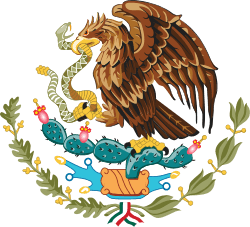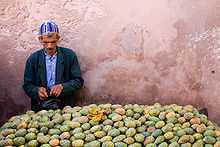Opuntia ficus-indica
| Opuntia ficus-indica | |
|---|---|
 | |
| Illustration by Eaton in The Cactaceae | |
| Scientific classification | |
| Kingdom: | Plantae |
| (unranked): | Angiosperms |
| (unranked): | Eudicots |
| (unranked): | Core eudicots |
| Order: | Caryophyllales |
| Family: | Cactaceae |
| Genus: | Opuntia |
| Subgenus: | Opuntia |
| Species: | O. ficus-indica |
| Binomial name | |
| Opuntia ficus-indica (L.) Mill. | |
| Synonyms[1] | |
| |
Opuntia ficus-indica is a species of cactus that has long been a domesticated crop plant important in agricultural economies throughout arid and semiarid parts of the world. It is thought to possibly be native to Mexico.[1] Some of the common English names for the plant and its fruit are Indian fig opuntia, barbary fig, cactus pear, spineless cactus, and prickly pear, although this last name has also been applied to other less common Opuntia species. In Mexican Spanish the plant is called nopal, while the fruit is called tuna, which are names also used in American English, especially as culinary terms.
Growth

Fig opuntia is grown primarily as a fruit crop, but also for the vegetable nopales and other uses. Most culinary references to the "prickly pear" are referring to this species. The name "tuna" is also used for the fruit of this cactus, and for Opuntia in general; according to Alexander von Humboldt, it was a word of Hispaniola native origin taken into the Spanish language around 1500 CE.[2]
_at_Secunderabad%2C_AP_W_IMG_6674.jpg)
Cacti are good crops for dry areas because they efficiently convert water into biomass. O. ficus-indica, as the most widespread of the long-domesticated cactuses, is as economically important as corn and tequila agave in Mexico today. Because Opuntia species hybridize easily (much like oaks), the wild origin of O. ficus-indica is likely to have been in Mexico due to the fact that its close genetic relatives are found in central Mexico.[3]
Uses


The most commercially valuable use for Opuntia ficus-indica today is for the large, sweet fruits, called tunas. Areas with significant tuna-growing cultivation include Mexico, Malta, Spain, Sicily and the coasts of Southern Italy, Greece, Libya, Tunisia, Morocco, Algeria, Lebanon, Syria, Egypt, Saudi Arabia, Yemen, Israel, Chile, Brazil, Turkey, as well as in Eritrea and Ethiopia where the fruit is called beles (Ge'ez: በለስ).[4] In Sicily, where the prickly pear fruit is known as ficudinnia (the Italian name being fico d'India, meaning "Indian fig"), the cactus grows wild and cultivated to heights of 12–16 ft (4–5 m). In Namibia, O. ficus-indica is a common drought-resistant fodder plant.[5]
The plants flower in three distinct colors: white, yellow, and red. The flowers first appear in early May through the early summer in the Northern Hemisphere, and the fruit ripen from August through October. The fruit are typically eaten, minus the thick outer skin, after chilling in a refrigerator for a few hours. They have a taste similar to a juicy, extra sweet watermelon. The bright red/purple or white/yellowish flesh contains many tiny hard seeds that are usually swallowed, but should be avoided by those who have problems digesting seeds.

Jams and jellies are produced from the fruit, which resemble strawberries and figs in color and flavor.
Mexicans have used Opuntia for thousands of years to make an alcoholic drink called colonche.
In the center of Sicily, in the Province of Enna, in a small village named Gagliano Castelferrato, a prickly pear-flavored liqueur is produced called "Ficodi", flavored somewhat like a medicinal/aperitif.
In the early 1900s in the United States, the prickly pear fruit was imported from Mexico and Mediterranean countries to satisfy the growing population of immigrants arriving from Italy and Greece. The fruit lost its popularity during the mid-1950s, but has increased in popularity since the late 1990s, due to the influx of Mexican immigrants.
Recently, the cattle industry of the Southwest United States has begun to cultivate O. ficus-indica as a fresh source of feed for cattle. The cactus is grown both as a feed source and a boundary fence. Cattle avoid the sharp spines of the cactus and do not stray from an area enclosed by it. Native prickly pear growth has been used for over a century to feed them; the spines can be burned off to reduce mouth injury. The cactus pads, on which the cattle feed, are low in dry matter and crude protein, but are useful as a supplement in drought conditions.[6] In addition to the food value, the moisture content virtually eliminates watering the cattle and the human effort in achieving that chore.
Mexican and other southwestern residents eat the young cactus pads (nopales, plural, nopal, singular), usually picked before the spines harden. They are sliced into strips, skinned or unskinned, and fried with eggs and jalapeños, served as a breakfast treat. They have a texture and flavor like string beans.
They can be boiled, used raw blended with fruit juice, cooked on a frying pan (tastes better than boiled), and they're often used as a side dish to go with chicken or added to tacos along with chopped onion and cilantro.
_flowering_at_Secunderabad%2C_AP_W_IMG_6673.jpg)
In Malta, a liqueur called bajtra (the Maltese name for prickly pear) is made from this fruit, which can be found growing wild in most every field. On the island of Saint Helena, the prickly pear also gives its name to locally distilled liqueur, Tungi Spirit.
Other uses include as an ingredient in adobe (to bind and waterproof).[3]
O. ficus-indica (as well as other species in Opuntia and Nopalea) is cultivated in nopalries to serve as a host plant for cochineal insects, which produce desirable red and purple dyes. This practice dates from pre-Columbian times.[7]
The plant is considered a pest species in parts of the Mediterranean Basin due to its ability to spread rapidly beyond the zones where it was originally cultivated. In Hebrew, the plant is referred to as sabres.[8] Kishkashta, a main character on a 1970-80s Israeli children's show, Ma Pit'om, was a large, talking felt puppet of the Opuntia cactus.
The high levels of selenium in Opuntia are comparable to those found in the Brassicaceae[9]
The fruit of O. ficus-indica can cause constipation if consumed with the seeds, without the seeds it is laxative.[10]

A University of South Florida engineering professor and a team of researchers have found that mucilage from the prickly pear cactus works as a natural, nontoxic dispersant for oil spills.[11]
Dietary information
The fruit contains vitamin C[12] and was one of the early cures for scurvy.[13]
The red colour of the juice is due to betalains (betanin and indicaxanthin), two molecules with antioxidant activity.[14]
The plant also contains the antioxidant flavonoids quercetin, (+)-dihydroquercetin (taxifolin), quercetin 3-methyl ether (isorhamnetin)[15] and kaempferol.[16]
Other constituents of the pulp of the fruit are carbohydrates (glucose and fructose, starch), proteins and fibers rich in pectin.[17]
Biogeography
Recent DNA analysis indicated O. ficus-indica was domesticated from Opuntia species native to central Mexico. The Codex Mendoza, and other early sources, show Opuntia cladodes, as well as cochineal dye (which needs cultivated Opuntia), in Aztec tribute rolls. The plant spread to many parts of the Americas in pre-Columbian times, and since Columbus, have spread to many parts of the world, especially the Mediterranean, where they have become naturalized (and in fact were believed to be native by many). This spread was facilitated by the carrying of nopales on ships to prevent scurvy.[3]
References
- ↑ 1.0 1.1 "Opuntia ficus-indica (L.) Mill.". USDA GRIN.
- ↑ Baron F. H. A. von Humboldt's personal narrative of travels to the equinoctial regions of America tr. 1852 by Ross, Thomasina: "The following are Haytian words, in their real form, which have passed into the Castilian language since the end of the 15th century... Tuna". Quoted in OED 2nd ed.
- ↑ 3.0 3.1 3.2 Griffith, M. P. (2004). "The Origins of an Important Cactus Crop, Opuntia ficus-indica (Cactaceae): New Molecular Evidence" (pdf). American Journal of Botany 91 (11): 1915–1921. doi:10.3732/ajb.91.11.1915.
- ↑ "Beles". Encyclopaedia Aethiopica: A-C. Wiesbaden: Harrassowitz Verlag. 2003.
- ↑ Rothauge, Axel (25 February 2014). "Staying afloat during a drought". The Namibian.
- ↑ Paschal, J. C. "Nutritional Value and Use of Prickly Pear for Beef Cattle". Texas A&M University.
- ↑ Kiesling, R. (1999). "Origen, Domesticación y Distribución de Opuntia ficus-indica (Cactaceae)". Journal of the Professional Association for Cactus Development 3: 50–60.
- ↑ This led to the popular use of the term Sabra to refer to an Israeli-born Jew, alluding to the fruit and the people alike being tenacious and thorny (rough and masculine) on the outside but sweet and soft (delicate and sensitive) on the inside.
- ↑ Bañuelos, G. S.; Fakra, S. C., Walse, S. S.; Marcus, M. A.; Yang, S. I.; Pickering, I. J.; Pilon-Smits, E. A.; Freeman, J. L. (January 2011). "Selenium Accumulation, Distribution, and Speciation in Spineless Prickly Pear Cactus: a Drought- and Salt-Tolerant, Selenium-Enriched Nutraceutical Fruit Crop for Biofortified Foods". Plant Physiology 155 (1): 315–327. doi:10.1104/pp.110.162867. PMC 3075757. PMID 21059825.
- ↑ Lentini, F.; Venza, F. (2007). "Wild Food Plants of Popular Use in Sicily". Journal of Ethnobiology and Ethnomedicine 3 (15). doi:10.1186/1746-4269-3-15. PMC 1858679. PMID 17397527.
- ↑ University of South Florida. "Cactus a Natural Oil Dispersant". USF News. Retrieved 21 June 2012.
- ↑ Am J Clin Nutr. "Supplementation with cactus pear (Opuntia ficus-indica) fruit decreases oxidative stress in healthy humans: a comparative study with vitamin C". National Center for Biotechnology Information.
- ↑ Carl Zimmer (December 10, 2013). "Vitamins’ Old, Old Edge". The New York Times.
- ↑ Antioxidant Activities of Sicilian Prickly Pear (Opuntia ficus indica) Fruit Extracts and Reducing Properties of Its Betalains: Betanin and Indicaxanthin. Daniela Butera, Luisa Tesoriere, Francesca Di Gaudio, Antonino Bongiorno, Mario Allegra, Anna Maria Pintaudi, Rohn Kohen and Maria A. Livrea, J. Agric. Food Chem., 2002, 50 (23), pages 6895–6901, doi:10.1021/jf025696p
- ↑ Neuroprotective effects of antioxidative flavonoids, quercetin, (+)-dihydroquercetin, and quercetin 3-methyl ether, isolated from Opuntia ficus-indica var. saboten. Hyang Dok-Go, Kwang Heun Lee, Hyoung Ja Kim, Eun Ha Lee, Jiyong Lee, Yun Seon Song, Yong-Ha Lee, Changbae Jin, Yong Sup Lee and Jungsook Cho, Brain Research, 7 March 2003, Volume 965, Issues 1–2, Pages 130–136, doi:10.1016/S0006-8993(02)04150-1
- ↑ Antioxidant compounds from four Opuntia cactus pear fruit varieties. Joseph O Kuti, Food Chemistry, May 2004, Volume 85, Issue 4, Pages 527–533, doi:10.1016/S0308-8146(03)00184-5
- ↑ Composition of pulp, skin and seeds of prickly pears fruit (Opuntia ficus indica sp.). Radia Lamghari El Kossori, Christian Villaume, Essadiq El Boustani, Yves Sauvaire and Luc Méjean, Plant Foods for Human Nutrition, 1998, Volume 52, Issue 3, pages 263-270, doi:10.1023/A:1008000232406
Further reading
| Wikimedia Commons has media related to Opuntia ficus-indica. |
- Anderson, E. F. (2001). The Cactus Family. Portland, OR, USA: Timber Press.
- Benson, L. H. (1982). The Cacti of the United States and Canada. Stanford, CA, USA: Stanford University Press.
- Donkin, R. (1977). "Spanish Red: An Ethnogeographical Study of Cochineal and the Opuntia Cactus". Transactions of the American Philosophical Society 67: 1–77. doi:10.2307/1006195.
- Griffith, M. P. (2004). "The Origins of an Important Cactus Crop, Opuntia ficus-indica (Cactaceae): New Molecular Evidence" (pdf). American Journal of Botany 91 (11): 1915–1921. doi:10.3732/ajb.91.11.1915.
- Kiesling, R. (1999). "Origen, Domesticación y Distribución de Opuntia ficus-indica (Cactaceae)". Journal of the Professional Association for Cactus Development 3: 50–60.